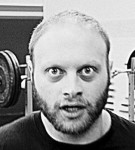Tom O asks, “I have calf pain when squatting ass-to-grass, whether back, front, or overhead. Any ideas what this could be/what I can do about it?”
Could be quite a few things. I’d start with soft tissue and mobility work on the hamstrings, IT band, and calves. Start at the largest crossed joint (hips for hamstrings and IT band, knee for calves) and work down. You may also want to do some compression work around your calves. Finally, address the squat (and the hips) as a whole. Do some range of motion testing (there is a lot of good stuff on Mobility WOD for this) and see where you’re limited. Address those issues and see where it leads. Perhaps of greatest importance, is to remember that dealing with issues like this is not a quick fix, one-and-done kind of deal. It’s going to take some time and patience, but it will pay off.
David H asks, “I’m a new weightlifter and I have long arms. Should I utilize a wide grip on the jerk? I’ve been using a relatively narrow grip and it feels more solid this way, but I can’t help but think I’d benefit from moving my hands out.”
If it ain’t broke, don’t fix it.
Joseph F asks “Box squat for CrossFitters?”
Star Wars action figures for Trekkies?

Harry S asks, “What are some ways to improve my mobility for the snatch? My bottom position looks like a low bar back squat due to tight hips and ankles, and the couch stretch alone isn’t covering it.”
In answering this, I’m going to assume you are already back squatting high bar. If you’re not, fix that, train it for 6 weeks, and see where you’re at. Second, while mobility and stretching is great, I’m a firm believer that the biggest changes are going to happen from doing a lot of the movement you’re trying to improve. Don’t become that guy who spends 2 hours on mobility and 20 minutes lifting (emphasis added by me because this is a glorious statement. – Cloud). With that out of the way, let’s talk about a few excellent drills to help you with this.
1. This one is very specifically helpful for people with your problem: take a length of PVC or broomstick and go into the bottom of your overhead squat. Have someone stand behind you, hands on the PVC, place their knee in your low back, and push your hips forward and down. Be sure to keep your weight on your heels as the knees go forward, and actively push up against the “bar.” Have your helper push down slightly on the PVC – this will help you feel something to push up against.
2. Holding an empty barbell in your hands, squat down and place the bar across your thighs/knees. Push one knee forward at a time (it’s fine to come off your heel) and use the bar to weigh you down at the knee. You should feel a deep stretch around the achilles tendon. Do this a little at a time, switching back and forth between legs, gradually loosening up the tissues and pushing the stretch further.
Barry S asks, “What are the pros and cons of using a percentage based training program for weightlifting?”
This is a big question. I will address it as concisely as possible.
Using percentages can be helpful because it gives you a governor. When done intelligently, in the long term, it can help keep you from doing too much or too little, ensure that you’re mostly working with loads that are beneficial to you, and give you an accurate measurement of the total training load from day to day, week to week, and month to month.
However, they can also be limiting. Is 80% as valuable as 85% or 90%? In my opinion, if you are having a good training day, you’re going to get more out of taking the weight up and working heavier than just sticking to a set number. And it’s always good to have the opportunity to strike when the iron is hot and set new PRs.
This is not to say that a percentage based program can’t work. There are obviously a lot of great lifters and coaches who use percentages. And I think they can be useful for someone who is training alone, to mitigate burnout and keep the lifter from getting to the point where they’re so exhausted that they are no longer able to recognize and correct mistakes.
Dave F asks, “If you were to design a program for someone looking to compete in both weightlifting and powerlifting, what would you emphasize?”
This is another big question, not one I can address effectively within the scope of this post. But I will say this: I very strongly believe that in order to be successful at both weightlifting and powerlifting, one would need to emphasize weightlifting as the main discipline. The short version of the long answer to the question “why?” is this: weightlifting has the potential to improve you as a powerlifter far more than powerlifting has the potential to improve you as a weightlifter. There is already great importance placed on squatting and pulling strength, and the bench press can be treated as a supplementary exercise for a large part of the year. I would, obviously, shift emphasis closer to a powerlifting meet for the final preparatory period.
 Jacob Tsypkin is a CrossFit and weightlifting coach, the co-owner of CrossFit Monterey and the Monterey Bay Barbell Club in Monterey, CA. He is available for weightlifting seminars and already has a perfect score on 13.4.
Jacob Tsypkin is a CrossFit and weightlifting coach, the co-owner of CrossFit Monterey and the Monterey Bay Barbell Club in Monterey, CA. He is available for weightlifting seminars and already has a perfect score on 13.4.

